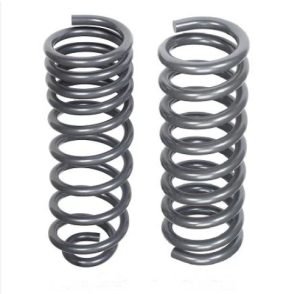When it comes to vehicle dynamics, few systems are as critical — or as misunderstood — as the suspension. A well-tuned suspension enhances handling, safety, comfort, and even tire longevity. At the heart of suspension tuning lies a delicate balance between spring rate and vehicle weight. This relationship determines how a vehicle responds to acceleration, braking, cornering, and uneven road surfaces.
In this article, we’ll explore the science of suspension tuning, how spring rates work, how they must match vehicle weight, and how to fine-tune your suspension for optimal performance. Whether you’re modifying a race car or improving your daily driver, mastering this balance is key.
What Is Spring Rate?

Spring rate refers to the amount of force required to compress a spring by a certain distance, typically expressed in:
-
N/mm (newtons per millimeter) in metric systems
-
lb/in (pounds per inch) in imperial systems
A higher spring rate means the spring is stiffer and resists compression more strongly, while a lower spring rate allows more movement under the same load.
Example:
-
A spring rated at 50 N/mm will compress 10 mm under a 500 N load.
-
A spring rated at 100 N/mm would compress only 5 mm under the same load.
Why Spring Rate Must Match Vehicle Weight
Your vehicle’s total weight — plus dynamic loads during driving — must be matched with the proper spring rate. If your springs are too soft, you’ll experience excessive body roll, dive, squat, and instability. If they’re too stiff, the ride becomes harsh, and tire contact with the road is compromised.
Spring Rate & Weight Balance Table
| Vehicle Type | Approx. Curb Weight (kg) | Recommended Spring Rate Range (N/mm) |
|---|---|---|
| Light hatchback | 1000–1200 | 25–40 |
| Compact sedan | 1200–1400 | 30–45 |
| Sports coupe | 1300–1600 | 40–70 |
| Mid-size SUV | 1600–2000 | 50–80 |
| Pickup or off-road SUV | 2000+ | 70–100+ |
Dynamic Load Transfer & Suspension Behavior
Vehicles don’t drive in static conditions. When you accelerate, brake, or corner, dynamic weight transfer occurs:
-
Braking shifts weight to the front
-
Acceleration shifts weight to the rear
-
Cornering shifts weight to the outer wheels
Your spring rate must account for these loads to prevent instability or imbalance.
Common Driving Issues from Improper Spring Rates
| Problem | Likely Spring Issue |
|---|---|
| Excessive brake dive | Front springs too soft |
| Rear-end squat on launch | Rear springs too soft |
| Poor cornering stability | Overall rate too soft |
| Harsh ride, bouncing | Springs too stiff |
Calculating Ideal Spring Rate
Although detailed suspension tuning involves complex equations, a simplified formula helps estimate a starting point:
Spring Rate (N/mm) = (Vehicle Corner Weight × Desired Frequency² × 0.0102)
Where:
-
Corner Weight = vehicle weight divided by 4 (per wheel)
-
Frequency = desired natural frequency (1.2–1.5 Hz for street, 1.7–2.5 Hz for performance)
Example: A 1200 kg car = 300 kg per wheel.
Desired frequency = 1.5 Hz.
Spring rate ≈ 300 × (1.5)² × 0.0102 ≈ 6.89 N/mm — multiply by actual shock geometry ratio for accuracy.
Front vs Rear Spring Rate
Most vehicles require different spring rates front and rear due to uneven weight distribution and different suspension layouts (MacPherson, multilink, etc.).
Front vs Rear Rate Balance Table
| Vehicle Layout | Front:Rear Weight Distribution | Typical Spring Rate Ratio |
|---|---|---|
| FWD (Front-heavy) | 60:40 | Front springs 20–30% stiffer |
| RWD (Balanced) | 50:50 | Near equal or slightly rear-biased |
| AWD Performance | 55:45 | Front slightly stiffer |
How to Tune Springs for Performance or Comfort
| Tuning Goal | Spring Rate Adjustment |
|---|---|
| Comfort | Lower rate, softer spring |
| Sportier handling | Higher rate, stiffer spring |
| Track performance | Aggressive rates + matched dampers |
| Load carrying/off-road | Progressive or stiffer linear springs |
Progressive vs Linear Springs
| Spring Type | Description | Best For |
|---|---|---|
| Linear | Constant rate through compression | Predictable, performance builds |
| Progressive | Increases resistance as compressed | Daily driving, variable loads |
Progressive springs offer a more comfortable ride initially but stiffen up under heavy loads or hard cornering.
Maintenance & Inspection Tips

To keep your spring system balanced and performing optimally:
-
Inspect for corrosion, cracks, or sagging every 20,000–30,000 km
-
Replace springs in pairs (front or rear)
-
Never mismatch spring and shock age or design
-
Ensure proper ride height and alignment after changes
-
Choose high-quality OEM or performance-rated springs
Costs of Upgrading or Replacing Springs
| Component | Cost Range (EUR) |
|---|---|
| Standard spring (per unit) | €40 – €100 |
| Performance coil spring | €100 – €250 |
| Progressive spring set | €150 – €400 |
| Labor for replacement | €100 – €250 |
| Wheel alignment | €50 – €80 |
Where to Buy Quality Springs
For durable, road-tested components that fit your specific vehicle and driving style, shop trusted suppliers.
Buy Springs & Components online
Whether you’re upgrading for handling or replacing worn factory springs, choosing the right product is key to suspension balance and safety.
Final Thoughts
Suspension tuning isn’t just for race cars — every driver benefits from a properly balanced spring rate matched to vehicle weight. It improves:
-
Ride comfort
-
Handling precision
-
Tire longevity
-
Brake and acceleration response
By understanding the science behind spring rate and its relationship to weight and dynamics, you can fine-tune your vehicle for your needs. Whether you’re a weekend track warrior or a daily commuter, suspension balance is essential to performance and safety.